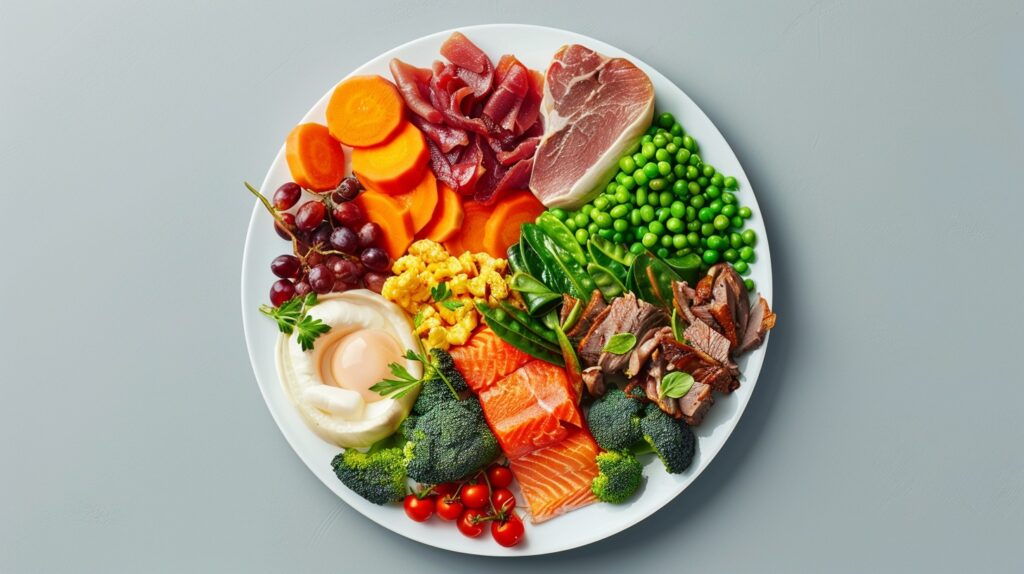Introduction
A well-balanced diet plan plays a crucial role in providing the essential nutrients your body needs to function correctly, supporting your immune system, and reducing the risk of chronic diseases. While the concept of a balanced diet is widely known, its implementation often requires careful planning and an understanding of nutrition. This comprehensive guide explores the fundamental components of a balanced diet chart, supported by credible research and expert advice, and offers actionable steps to prepare a balanced diet chart tailored to your health needs.
A well-balanced diet plan isn’t just about counting calories; it’s about getting the right types of foods in the right amounts to nourish your body for optimal health. We’ll examine how to balance macronutrients like carbohydrates, proteins, and fats, and why micronutrients like vitamins and minerals are equally important. Additionally, we’ll address common dietary mistakes, provide practical tips for meal planning, and discuss how to adjust your diet as your health needs evolve, ensuring you’re always following a holistic eating plan that supports long-term wellness.
What is a Balanced Diet?
A balanced diet consists of various foods in the right proportions to provide the essential nutrients—carbohydrates, proteins, fats, vitamins, and minerals—required for maintaining health and energy levels. According to the World Health Organization (WHO), a balanced diet helps protect against malnutrition and noncommunicable diseases like diabetes, heart disease, stroke, and cancer.
A well-balanced diet plan is not a one-size-fits-all concept. It can vary depending on an individual’s age, sex, lifestyle, and health status. For instance, athletes may require more protein and carbohydrates than sedentary individuals, while older adults may need more calcium and vitamin D to maintain bone health. The key is to understand your body’s unique nutritional requirements and choose a variety of foods that fulfill those needs.
Table 1: Key Nutrients and Their Sources
| Nutrient | Function | Sources |
| Proteins | Building and repairing tissues | Lean meats, beans, nuts, dairy |
| Carbohydrates | Primary energy source | Whole grains, fruits, vegetables |
| Fats | Energy source, essential for cell function | Avocados, nuts, seeds, olive oil |
| Vitamins | Regulate body processes | Fruits, vegetables, dairy |
| Minerals | Support various bodily functions | Leafy greens, dairy, nuts, seeds |
The Importance of Macronutrients
Macronutrients—Carbohydrates, Proteins, and Fats—are the foundation of a well-balanced diet plan that supports optimal health. Each macronutrient plays a crucial role in maintaining optimal health:
- Fats: Fats are vital for energy, cell function, and the absorption of fat-soluble vitamins (A, D, E, and K). Healthy fats, like those found in avocados, nuts, seeds, and olive oil, are important for optimal health. However, it’s important to limit saturated fats and avoid trans fats, which can lead to heart disease. Ensuring the right balance of fats in your diet is key to preparing a well-balanced diet plan.
- Carbohydrates: As the body’s main energy source, carbohydrates are broken down into glucose, which provides fuel for the body. Complex carbohydrates, found in whole grains, fruits, and vegetables, offer sustained energy and are high in fiber, promoting digestive health. Including complex carbs in your balanced diet chart is essential for long-lasting energy.
- Proteins: Essential for building and repairing tissues, making enzymes and hormones, and supporting immune function, proteins are composed of amino acids. Some of these amino acids must be obtained through diet. Lean meats, fish, eggs, beans, and legumes are high-quality protein sources that should be part of any holistic eating plan.
The Role of Micronutrients
Micronutrients, including vitamins and minerals, are vital for maintaining overall health. They support a range of bodily functions, from bone health to immune function and energy production. Unlike macronutrients, micronutrients are required in smaller amounts but are no less important.
- Vitamins: Vitamins are organic compounds necessary for various metabolic processes. For example, vitamin C is important for the immune system and skin health, while vitamin D is crucial for bone health.
- Minerals: Minerals, such as calcium, magnesium, and iron, are inorganic elements that play key roles in bone health, muscle function, and oxygen transport in the blood. A diet rich in fruits, vegetables, dairy, and whole grains usually provides an adequate amount of these essential minerals.
Step-by-Step Guide to Creating a Balanced Diet Plan
1. Determine Your Caloric Needs
Understanding your daily caloric needs is the first step in creating a balanced diet chart. Your caloric needs depend on various factors such as age, gender, activity level, and overall health goals. The National Institutes of Health (NIH) provides a detailed guide for calculating your caloric requirements based on these factors. You can use the NIH Body Weight Planner to estimate your daily caloric needs and create a personalized plan.
Once you know your caloric needs, you can start planning your meals accordingly. It’s important to remember that while calorie counting can be helpful, the quality of the calories you consume is equally important. Focus on nutrient-dense foods that provide vitamins, minerals, and other essential nutrients, rather than empty calories from sugary or highly processed foods.
2. Incorporate a Variety of Foods
Eating a wide range of foods ensures that you get all the nutrients your body needs. Variety is not only the spice of life but also the foundation of a balanced diet. Each food group offers unique nutrients that contribute to overall health. By incorporating a variety of foods, you can enjoy a wide array of flavors and textures while ensuring nutritional adequacy.
- Fruits and Vegetables: Aim for at least five portions of fruits and vegetables each day. These foods are rich in vitamins, minerals, antioxidants, and dietary fiber. They help reduce the risk of chronic diseases and promote optima health. The Centers for Disease Control and Prevention (CDC) emphasizes the importance of consuming a variety of colorful fruits and vegetables to maximize nutrient intake.
- Whole Grains: Whole grains, such as oats, brown rice, quinoa, and whole wheat, are excellent sources of complex carbohydrates, fiber, and essential nutrients like B vitamins and iron. These foods provide sustained energy and help maintain digestive health.
- Lean Proteins: Protein is essential for muscle growth, tissue repair, and enzyme production. Include a variety of protein sources, such as lean meats, fish, eggs, tofu, and legumes. For vegetarians and vegans, plant-based proteins like beans, lentils, chickpeas, and quinoa are excellent options.
- Healthy Fats: Incorporate healthy fats from sources like avocados, nuts, seeds, and olive oil. These fats are important for brain health, hormone production, and the absorption of fat-soluble vitamins. The American Heart Association (AHA) recommends choosing unsaturated fats over saturated fats to support heart health.

In addition to variety, it’s important to pay attention to food quality. Whenever possible, choose whole, unprocessed foods over processed and packaged foods. Whole foods retain more nutrients and are free from added sugars, unhealthy fats, and artificial ingredients. Organic produce, grass-fed meats, and wild-caught fish are excellent choices for those who want to avoid pesticides, hormones, and antibiotics in their diet.
3. Control Portion Sizes
Portion control is critical in preventing overeating and maintaining optimal health. Research from the American Heart Association (AHA) suggests that mindful eating and proper portion sizes are key to a balanced diet. Overeating, even healthy foods, can lead to weight gain and related health issues.
Portion control doesn’t mean you have to eat less; it means you should be mindful of how much you eat. Start by familiarizing yourself with standard portion sizes. For example:
- 1 cup of cooked vegetables is roughly the size of a baseball.
- 3 ounces of cooked meat is about the size of a deck of cards.
- 1 cup of cooked grains like rice or pasta is equivalent to a tennis ball.
Using smaller plates and bowls can also help you control portions. Studies have shown that people tend to eat more when served larger portions, even if they’re not hungry. By serving food on smaller dishes, you can trick your brain into feeling satisfied with less food.
The relationship between portion sizes and caloric intake is crucial. Portion control is particularly important when eating out, where portions are often much larger than necessary. One strategy is to ask for half of your meal to be packed up before you start eating or share a dish with a friend. At home, try pre-portioning snacks instead of eating directly from the bag, and avoid eating in front of the TV or computer, where it’s easy to lose track of how much you’ve consumed.
4. Plan Your Meals and Snacks
Creating a weekly meal plan can help you stick to a well-balanced diet plan, save time, and reduce stress. Meal planning allows you to be intentional about what you eat, ensuring that you get a variety of nutrients and avoid unhealthy, last-minute food choices.
Start by choosing a few recipes that incorporate a balance of macronutrients—carbohydrates, proteins, and fats—and prepare a balanced diet chart of the ingredients you’ll need. When planning your meals, consider your schedule and plan for leftovers to minimize waste and reduce the temptation to order takeout.
Sample Meal Plan
Day 1
- Breakfast: Oatmeal with berries, nuts, and a dollop of Greek yogurt
- Lunch: Grilled chicken salad with mixed greens, cherry tomatoes, cucumbers, and vinaigrette dressing
- Dinner: Baked salmon with quinoa, steamed broccoli, and a side of mixed vegetables
- Snack: Apple slices with almond butter
Day 2:
- Breakfast: Smoothie made with spinach, banana, protein powder, and almond milk
- Lunch: Whole grain wrap with turkey, avocado, lettuce, and tomato
- Dinner: Stir-fried tofu with brown rice and a medley of stir-fried vegetables (carrots, bell peppers, snap peas)
- Snack: Greek yogurt with a drizzle of honey and mixed nuts
Day 3:
- Breakfast: Scrambled eggs with spinach and whole grain toast
- Lunch: Lentil soup with a side of mixed greens salad
- Dinner: Grilled chicken with sweet potato wedges and steamed asparagus
- Snack: A small bowl of mixed berries
5. Stay Hydrated
Staying hydrated is an often-overlooked but essential component of a holistic eating plan. Water is vital for nearly every bodily function, from regulating body temperature to transporting nutrients and waste products. The Mayo Clinic recommends drinking at least 8 cups (2 liters) of water a day, though individual needs may vary based on factors like activity level, climate, and overall health.
To ensure you’re drinking enough water, consider carrying a reusable water bottle with you throughout the day and setting reminders to drink water. If you find plain water boring, try infusing it with slices of citrus, cucumber, or fresh herbs like mint for added flavor. Additionally, foods with high water content, such as cucumbers, watermelon, and oranges, can contribute to your hydration needs.
6. Monitor Your Progress
Monitoring your progress is crucial for staying on track with your well-balanced diet plan. Tracking your dietary habits can help you identify areas where you might need to make adjustments, and it can also provide motivation as you see your progress over time.
Consider using a food diary, whether on paper or through a mobile app, to record what you eat and drink each day. This can help you stay accountable and make more informed food choices. You might also track other factors like your energy levels, mood, and physical activity, as these can be affected by your diet.
For more personalized guidance, consider consulting with a registered dietitian or nutritionist. These professionals can help you tailor your diet plan to your specific needs, taking into account any health conditions, dietary restrictions, or fitness goals you might have.
Research-Backed Tips for Optimal Health
1. Incorporate Fiber
Fiber is an essential component of a well-balanced diet plan that often gets overlooked. It plays a critical role in maintaining digestive health, supporting heart health, and helping to control blood sugar levels. A study published in the Journal of Nutrition found that dietary fiber helps with weight management and reduces the risk of heart disease.
There are two types of dietary fiber: soluble and insoluble. Soluble fiber, found in foods like oats, beans, and apples, helps lower blood cholesterol and glucose levels. Insoluble fiber, found in whole grains, nuts, and many vegetables, helps move food through your digestive system and prevents constipation. To increase your fiber intake, aim to include a variety of fiber-rich foods in your diet, such as:
- Fruits: Apples, oranges, bananas, and berries
- Vegetables: Broccoli, carrots, and Brussels sprouts
- Whole Grains: Oats, brown rice, and whole wheat bread
- Legumes: Lentils, beans, and chickpeas
- Nuts and Seeds: Almonds, chia seeds, and flaxseeds
2. Limit Processed Foods
Processed foods are often high in unhealthy fats, sugars, and sodium, which can contribute to chronic diseases such as obesity, heart disease, and diabetes. According to the Harvard T.H. Chan School of Public Health, limiting processed foods and focusing on whole, minimally processed foods is a key component of a holistic eating plan.
Processed foods often contain added sugars, unhealthy fats, and preservatives that can be harmful to your health when consumed in excess. These foods are typically high in calories but low in nutritional value, meaning they can contribute to weight gain without providing the essential nutrients your body needs. To limit your intake of processed foods, try the following tips:
- Read Labels: When shopping, read nutrition labels to check for added sugars, unhealthy fats, and sodium. Choose products with minimal ingredients and avoid those with long lists of additives.
- Cook at Home: Preparing meals at home gives you control over the ingredients and cooking methods, allowing you to avoid the hidden sugars, fats, and sodium often found in restaurant and processed foods.
- Choose Whole Foods: Focus on whole, unprocessed foods like fresh fruits and vegetables, whole grains, lean proteins, and healthy fats. These foods provide more nutrients and fewer empty calories.
3. Practice Mindful Eating
Mindful eating is a practice that involves paying full attention to the experience of eating and drinking, both inside and outside the body. It helps you become more aware of your hunger and fullness cues, the taste and texture of food, and the emotions associated with eating. Research from the American Journal of Clinical Nutrition shows that mindful eating can improve your relationship with food and help you make healthier choices.
Mindful eating encourages you to slow down, savor each bite, and recognize the difference between physical hunger and emotional cravings. It can help you avoid overeating, make healthier food choices, and enjoy your meals more fully. To practice mindful eating:
- Eat Slowly: Take your time to chew each bite thoroughly and savor the flavors and textures of your food.
- Eliminate Distractions: Avoid eating in front of the TV, computer, or phone. Focus solely on your meal.
- Listen to Your Body: Pay attention to your body’s hunger and fullness signals. Stop eating when you feel satisfied, not stuffed.
Mindful eating can be particularly helpful when trying to make lasting dietary changes, as it promotes a more positive and intentional relationship with food.
Common Mistakes to Avoid
Even with the best intentions, it’s easy to make mistakes when trying to maintain optimal health. Here are some common pitfalls to watch out for:
1. Skipping Meals
Skipping meals, particularly breakfast, can lead to overeating later in the day and negatively affect your energy levels. When you skip a meal, your body may go into “starvation mode,” slowing down your metabolism and increasing the likelihood of weight gain when you do eat. The Harvard Medical School emphasizes the importance of regular meals, especially breakfast, to kickstart your metabolism and provide sustained energy throughout the day.
2. Overconsumption of One Food Group
A well-balanced diet plan requires a diversity of foods. Focusing too much on one type of food, even if it’s healthy, can lead to nutrient imbalances. For example, eating too much protein at the expense of carbohydrates and fats can deprive your body of essential nutrients needed for energy and overall health. Balance is key to ensuring you get all the nutrients your body needs.
Overconsumption of any food group, even healthy ones, can lead to nutrient imbalances. For instance, while protein is essential for muscle repair and growth, consuming excessive amounts at the expense of carbohydrates and fats can leave your body lacking in other necessary nutrients. Each macronutrient and micronutrient play a unique role in maintaining optimal health, so it’s important to include a variety of foods in your diet.
3. Relying on Supplements Over Whole Foods
While dietary supplements can be helpful in addressing specific nutrient deficiencies, they should not replace whole foods in your diet. Whole foods provide a complex matrix of nutrients, fiber, and phytochemicals that work synergistically to promote optimal health. According to the National Institutes of Health (NIH), most nutrients are best absorbed from food sources, where they are present in their natural form.
Supplements can be useful in certain situations, such as for individuals with specific nutrient deficiencies or medical conditions that impair nutrient absorption. However, for the majority of people, a holistic eating plan rich in whole foods should provide all the necessary nutrients. If you believe you need a supplement, it’s best to consult with a healthcare provider to determine the appropriate type and dosage.
By making thoughtful choices and avoiding common pitfalls, you can prepare a balanced diet chart that promotes optimal health and supports your goals for a healthier, happier life. Use the optima health login to access personalized resources and support on your wellness journey.
Adapting Your Diet for Specific Needs
Your dietary needs can change depending on various factors such as age, gender, activity level, and health status. It’s important to adapt your diet to meet these changing needs to maintain optimal health.
1. Diet for Active Individuals
Active individuals, including athletes, have higher energy and nutrient needs to support their physical activity levels. According to the Academy of Nutrition and Dietetics, carbohydrates are especially important for fueling exercise, while protein is crucial for muscle recovery. Healthy fats are also necessary for sustained energy and overall health. To support your active lifestyle, focus on the following:
- Carbohydrates: Include complex carbohydrates like whole grains, fruits, and vegetables to provide sustained energy.
- Protein: Consume lean proteins such as chicken, fish, tofu, and legumes to support muscle repair and growth.
- Hydration: Ensure adequate hydration before, during, and after exercise. Electrolyte-rich beverages may be beneficial during prolonged physical activity.
2. Diet for Older Adults
As we age, our nutritional needs change. Older adults may require fewer calories but more of certain nutrients, such as calcium, vitamin D, and fiber, to maintain bone health, support immune function, and promote digestive health. The National Institute on Aging (NIA) emphasizes the importance of nutrient-dense foods for older adults to meet their nutritional needs without consuming excess calories. For older adults, consider the following dietary adjustments:
- Calcium and Vitamin D: These nutrients are essential for maintaining optima health of bone and preventing osteoporosis. Include dairy products, leafy greens, and fortified foods in your diet.
- Fiber: Fiber helps maintain digestive health and prevent constipation. Include whole grains, fruits, vegetables, and legumes in your diet.
- Protein: Adequate protein intake is important for maintaining muscle mass and strength. Include lean meats, fish, eggs, and plant-based proteins in your diet.
3. Diet for Individuals with Chronic Conditions
Individuals with chronic conditions such as diabetes, heart disease, or hypertension may need to follow specific dietary guidelines to manage their health. The American Diabetes Association (ADA) and the American Heart Association (AHA) provide detailed dietary recommendations for managing these conditions.
For individuals with chronic conditions, it’s important to work with a healthcare provider or registered dietitian to create a personalized diet plan that meets your specific needs. This may include:
- Limiting Sodium: To manage blood pressure, individuals with hypertension should limit their intake of sodium by reducing processed foods and choosing low-sodium alternatives.
- Controlling Carbohydrates: For individuals with diabetes, managing carbohydrate intake is crucial for controlling blood sugar levels. Focus on whole grains, vegetables, and legumes, and monitor portion sizes.
- Increasing Omega-3 Fatty Acids: Omega-3 fatty acids, found in fish like salmon and mackerel, as well as flaxseeds and walnuts, are beneficial for heart health.
Conclusion
Creating a balanced diet plan is a powerful step toward achieving optimal health. By understanding your nutritional needs, incorporating a variety of foods, practicing portion control, and making mindful choices, you can develop a diet that supports your overall well-being. Remember, a balanced diet is not about strict limitations or depriving yourself of the foods you love; it’s about feeling great, having more energy, and improving your optima health.
To maintain a balanced diet, it’s essential to stay informed and adaptable. As your life circumstances and health needs evolve, so too should your diet. Whether you’re an athlete, an older adult, or someone managing a chronic condition, there’s a balanced diet plan that can work for you.
Tags: Optimal Health, A Balanced Diet Chart, Optima Health, Prepare A Balanced Diet Chart, Organic Foods
References
- World Health Organization (WHO). Healthy Diet.
- National Institutes of Health (NIH). Body Weight Planner.
- Harvard T.H. Chan School of Public Health. Healthy Eating Plate.















